A Swarm of Starlit Skies
Observations of unloved species, with the constant companionship of hummingbirds
Migraines and deadlines confined me to my garden for a period of a few weeks — no nature adventures beyond my neighborhood and no trips to any park.
Hummingbirds accompany me in the garden, no matter how briefly I am outdoors. On migraine mornings, they soothe me with their squeaky songs; their airborne dance distracts me from pain.
One of these mornings, I found the hummingbirds darting around the hibiscus, but not stopping to visit the flowers themselves or even the feeders nearby. Paper wasps ate sugar from the sides of the hummingbird feeders, as they often do. When the hummingbirds approach, the wasps fly toward them, menacingly, before returning to the feeders and continuing to monopolize them. This morning, however, carpenter bees joined the wasps at the feeders.
Overhead, dozens of carpenter bees, more than I had ever seen in this garden, frantically flew among the front garden hibiscus. Each flower held carpenter bees and nothing else. Carpenter bees crowded the faces of each flower, circling the surface as they stuck their own faces into it, feeding. I counted seven bees on one flower alone. Distraught, the hummingbirds hovered and chirped; finally one arced away to the patch of salvia to visit blooms perhaps not fully robbed of nectar by the carpenter bees.
Later in the day, calm returned to the garden. Only a few paper wasps remained to bully the hummingbirds at the feeders. The carpenter bees had dispersed, and the hummingbirds were free to visit the hibiscus again.
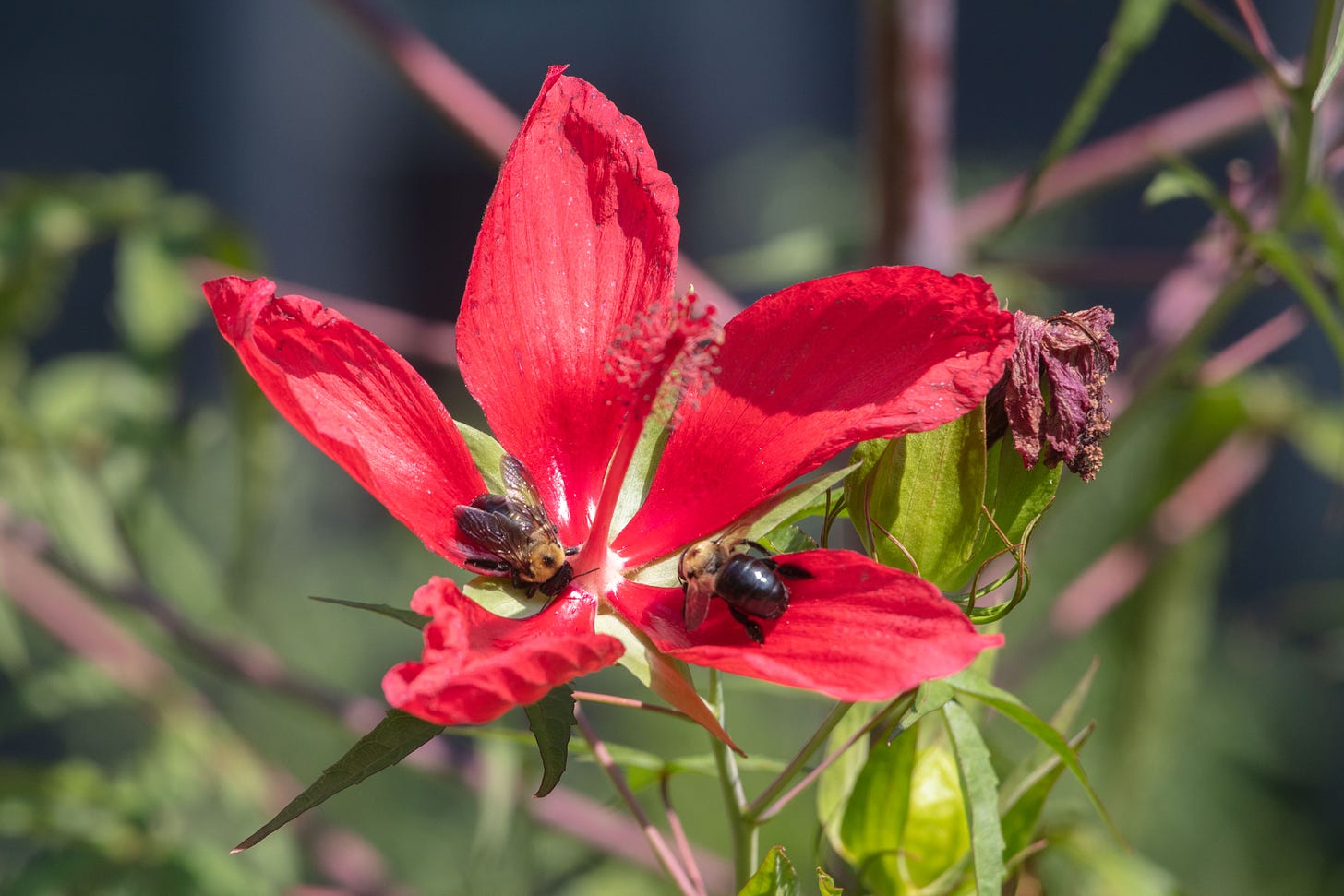
A few days later, on a humid Sunday morning, mosquitoes joined the hummingbirds, two sets of airborne companions dancing around me as I pulled weeds in the back garden.
The erratic, arcing flight of a black-and-white mosquito wound toward me. Reflexively, I swatted the air, expecting the breeze to send her away, but my hand made contact. She fell, sideways, and landed on the sleeve of my shirt. I studied the still body against the bright blue fabric of the sunscreen shirt I wear in the garden. Rarely do I get such an opportunity; my view of this species is gray movement, blurry and indistinct like the drops of drizzling rain.
White speckled this mosquito’s black body, like a sky full of stars. White and black striped her long, graceful legs. Those stripes give her species, Aedes albopictus, its common name — Asian tiger mosquito. If she weren’t a member of an invasive species that carries disease and, on a daily basis, irritates me, I would only write about how beautiful she is— her body like a galaxy painted on the head of a pin.
When a swarm of her species rises in the air in front of me, a twisting gray fog that obscures my path and my vision like clouds of worry, I would instead celebrate the tiny universe that appears before me. I would compare the mosquitoes to a blessing of tiny nighttime skies dancing in the air, not a collection of perseverative thought loops weaving a trap of anxiety. I would see these insects not as a tangible metaphor for fretful rumination, but as a swarm of starlit skies.
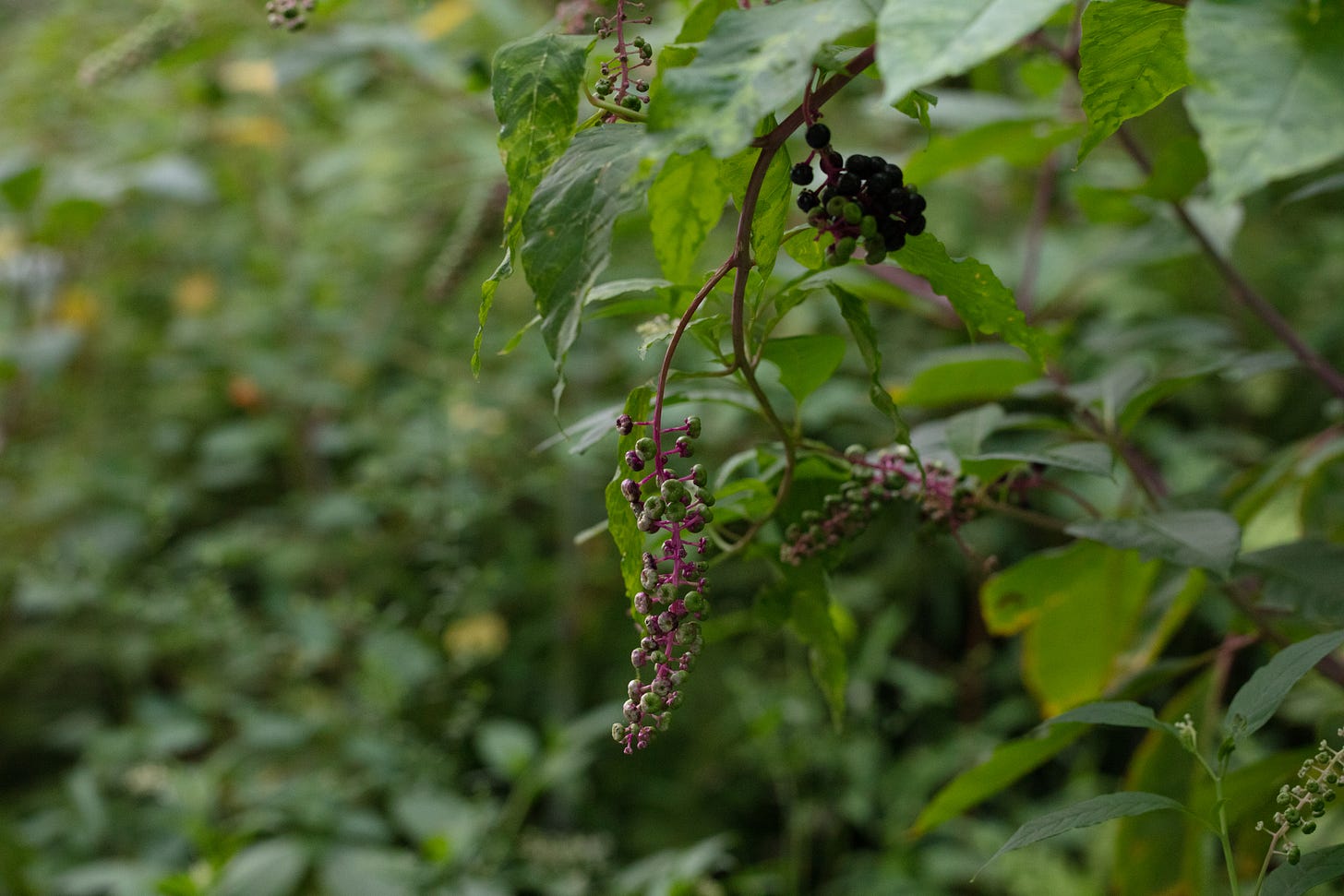
Nearby, the hot pink pokeweed stands like a small tree, cascading branches bedecked with large green leaves and pendulous stalks of flowers and fruit. Green stems of delicate white flowers have become hot pink peduncles with big round berries, mostly pale green this morning, though some have ripened to shiny, dark fruits like black pearls.
This much-maligned plant finds welcome in my garden. Insects visit the flowers, birds eat the fruit, and I admire its stately form and brilliant colors. Even the leaves are lovely, bright green in contrast with the magenta stems and stalks. Pokeweed Mosaic Virus frequently infects these plants and transforms the leaves into mottled gold and green works of art; lit by summer sun, they glow like stained glass.
The previous evening, a brown thrasher timidly shuffled across the garden before its short, furtive flight into the Chickasaw plum tree, whose leafy boughs hid the bird from view. Only the shaking of branches gave away the bird’s presence. Curious, I crept slowly to the porch, peeking at the back of the tree. Clumsily, competing with the shaking of the tree branch, the brown thrasher plucked the black berries from the closest pokeweed stalk.
A few days later, a mockingbird launched itself up from the ground, tail flaring out like a black and white cape, and landed on the pokeweed branches. I watched the mockingbird feast on the ripe fruits.
Even hummingbirds hover among the pokeweed, retrieving nectar from the small, white flowers.
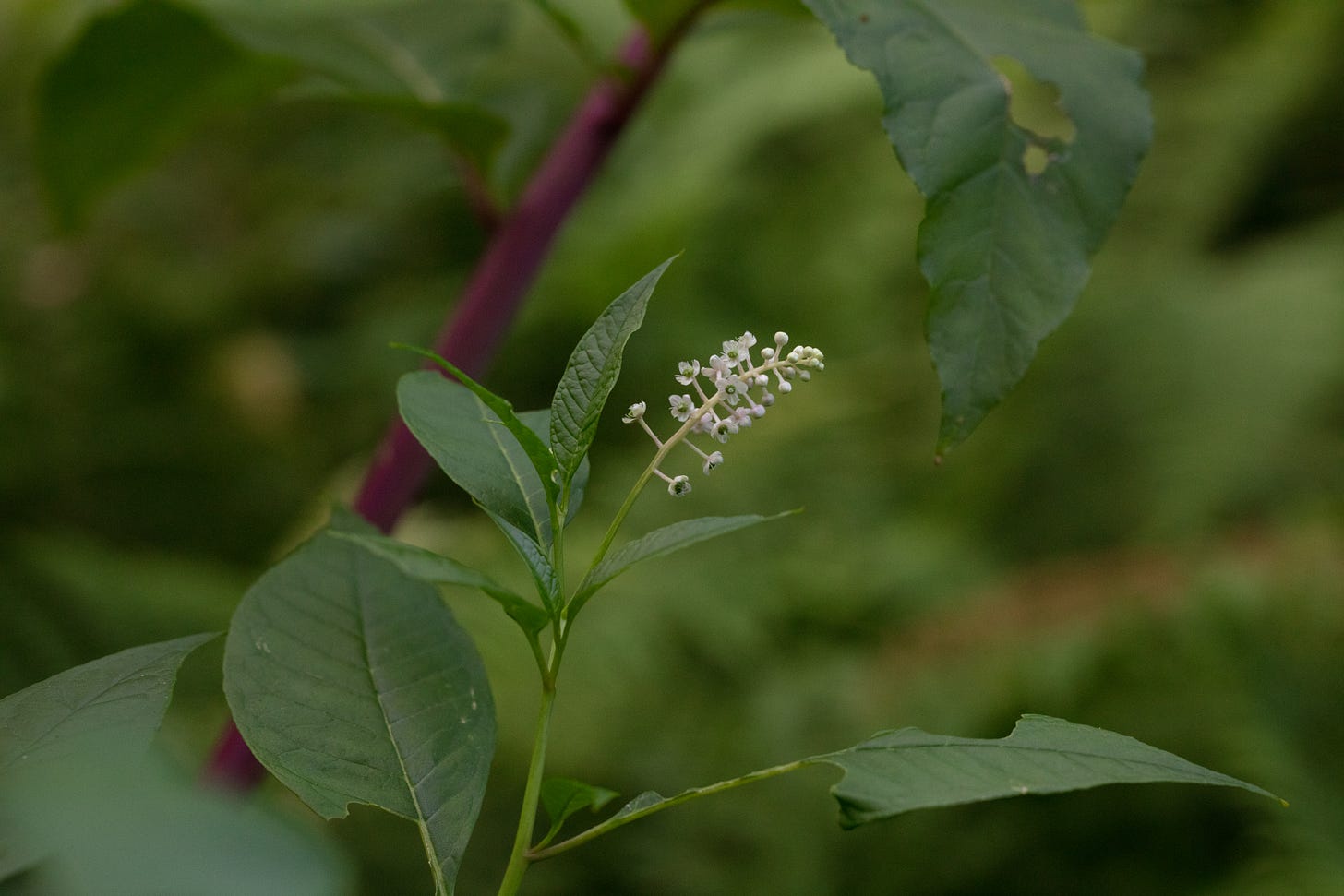
This particular morning, the hummingbirds led me down the back garden hill, squeaking urgently until I replaced an empty feeder. The flight of another black-and-white insect grabbed my attention and pulled me further down the hill. A single Zethus spinipes, a solitary wasp with no common name, passed over the flowering perennials and landed on the leaves of a witch-hazel tree.
The wasp seemed to bury its head in the surface of the leaf; its narrow black wings, extending straight from the wasp’s upper body, pointed out from the wasp’s head, forming a V. The wasp moved along the edge of the leaf, slowly revealing its threadlike waist and the small, white, triangular markings on its back and abdomen. As I watched, a piece of witch-hazel leaf disconnected from the plant; one of the wasp’s legs seemed to pierce the piece of leaf. After traveling along the edge of the leaf for some time, the wasp flew away, carrying with it the torn piece of witch-hazel leaf.
Had the wasp intentionally removed the leaf fragment? As I stared down, transfixed, pondering, an urgent squeak raced toward me from the sky. A small cyclone of gray began to wrap around me; one small mosquito untangled herself from the crowd, preparing to pierce my skin. Drawn back up the hill, I retrieved my trowel and went back to my garden tasks.
On Zethus spinipes — I have attempted to research the unusual behavior I witnessed. Does Zethus spinipes sculpt structures like other potter wasps? Are those structures made of chewed up leaves? Does Zethus spinipes eat leaves? Is there something special about witch hazel? It appears little is known about this species, and its nesting habits are virtually unknown. In my research, I found this short, readable, and interesting article. E. E. Grissell, Mason Wasps of Florida, Zethus spp. (Insecta: Hymenoptera: Vespidae: Eumeninae).




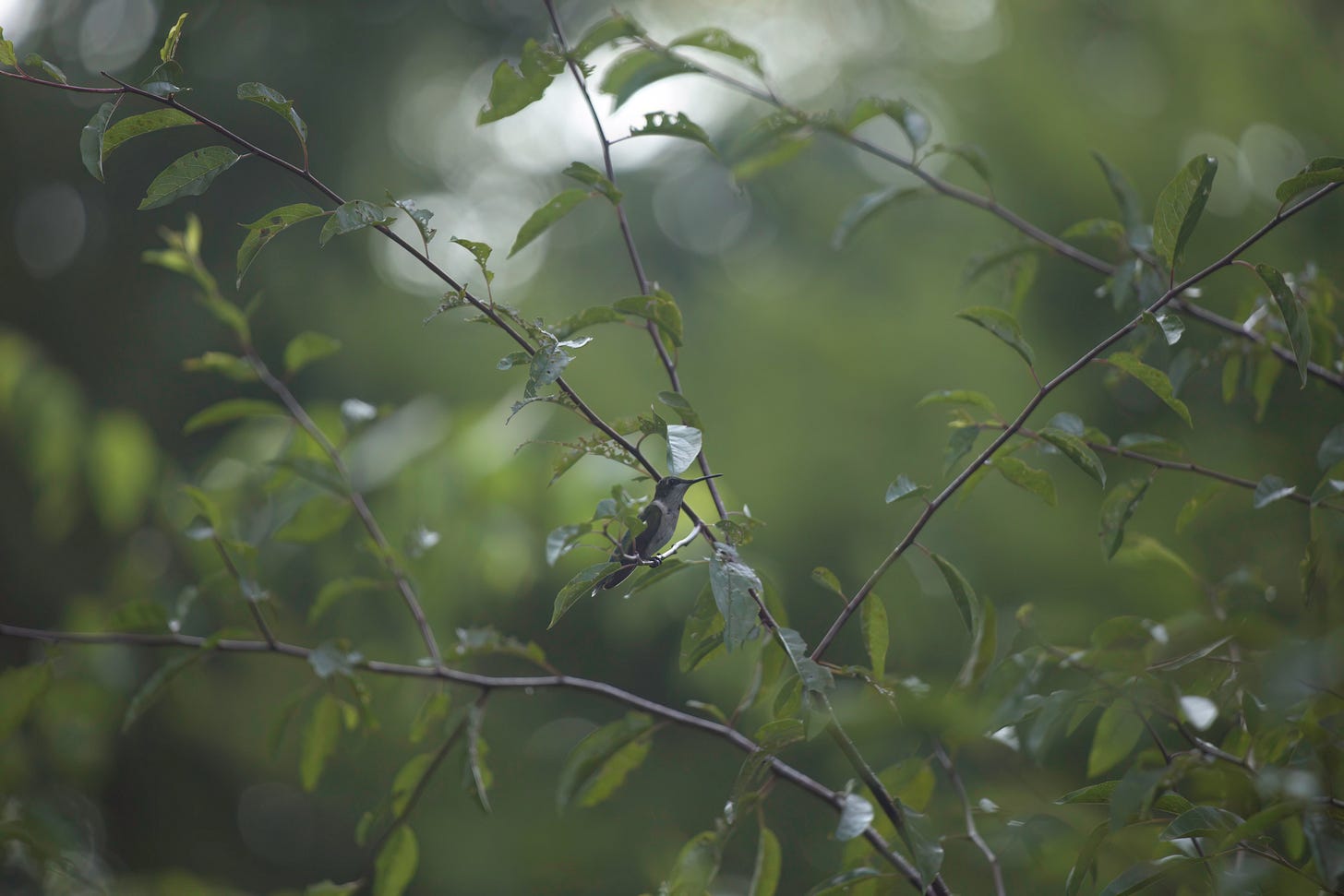
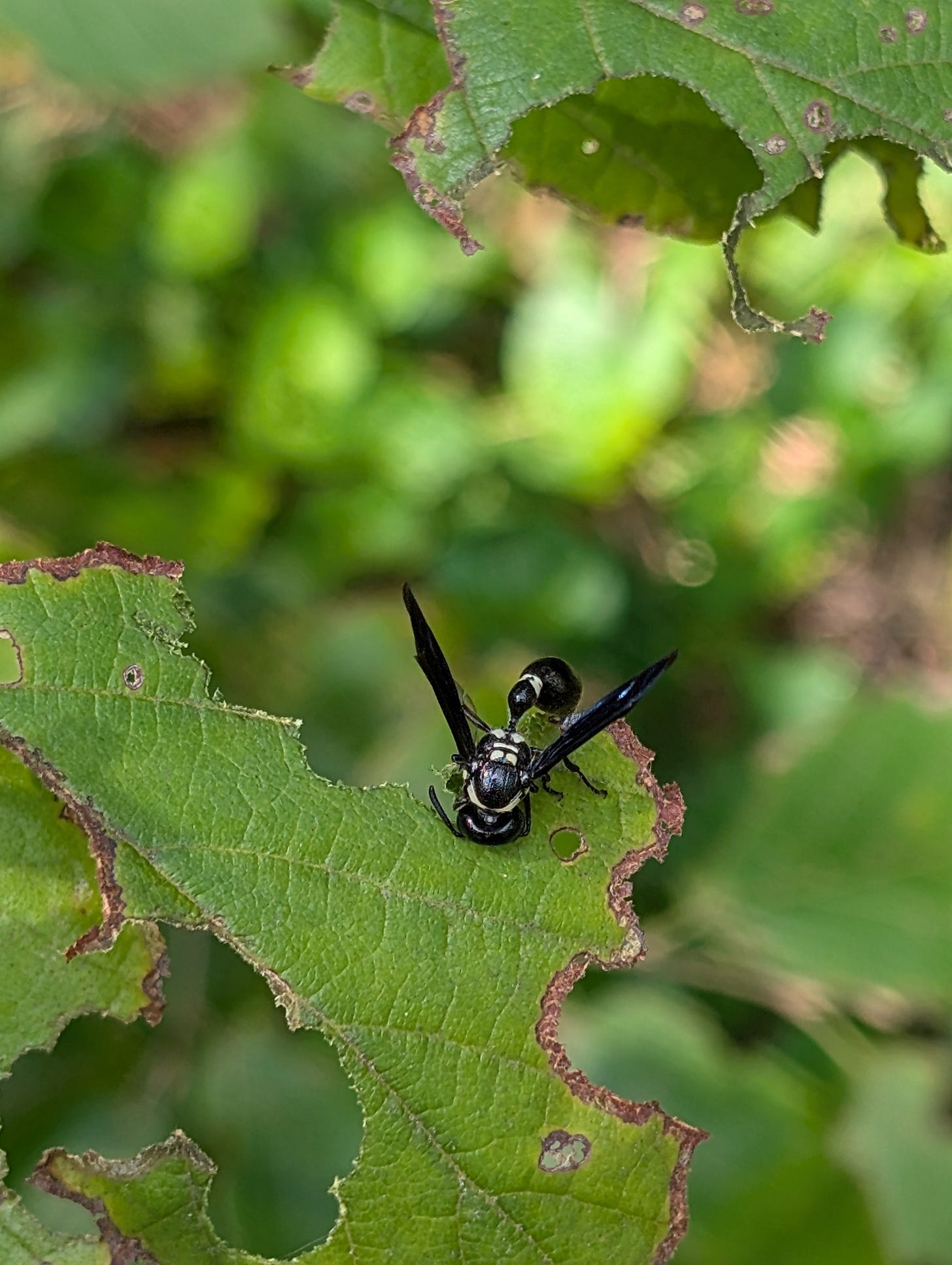
I greatly enjoyed this story, particularly the description of how you came to appreciate the mosquito
This is awesome!!